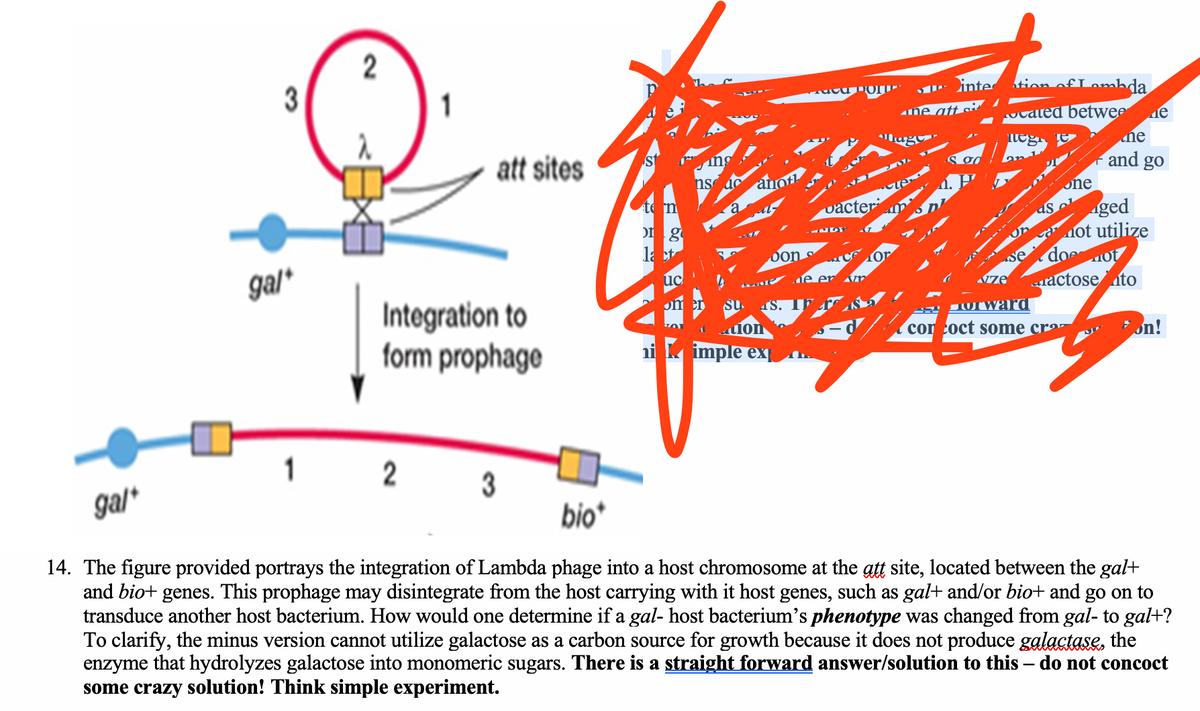The figure provided portrays the integration of Lambda phage into a host chromosome at the att site, located between the gal+ and bio+ genes. This prophage may disintegrate from the host carrying with it host genes, such as gal+ and/or bio+ and go on to ransduce another host bacterium. How would one determine if a gal- host bacterium's phenotype was changed from gal- to gal+? To clarify, the minus version cannot utilize galactose as a carbon source for growth because it does not produce galactase, the
The figure provided portrays the integration of Lambda phage into a host chromosome at the att site, located between the gal+ and bio+ genes. This prophage may disintegrate from the host carrying with it host genes, such as gal+ and/or bio+ and go on to ransduce another host bacterium. How would one determine if a gal- host bacterium's phenotype was changed from gal- to gal+? To clarify, the minus version cannot utilize galactose as a carbon source for growth because it does not produce galactase, the
Biology: The Unity and Diversity of Life (MindTap Course List)
15th Edition
ISBN:9781337408332
Author:Cecie Starr, Ralph Taggart, Christine Evers, Lisa Starr
Publisher:Cecie Starr, Ralph Taggart, Christine Evers, Lisa Starr
Chapter20: Viruses, Bacteria, And Archaea
Section: Chapter Questions
Problem 1DAA: Bacteriophage-Inspired Antibiotics Although bacteriophages have been infecting bacteria for billions...
Related questions
Question
100%

Transcribed Image Text:2
3
inte
tion of Lormhda.
ne att si
ucated betwee de
ne
att sites
and go
ns
one
te n
vacter
aged
ot utilize
doot
ractose ato
la t
don s
gal*
uc
Integration to
form prophage
om
SOward
cor coct some cro
on!
ni imple ex
2
3
bio*
gal*
14. The figure provided portrays the integration of Lambda phage into a host chromosome at the att site, located between the gal+
and bio+ genes. This prophage may disintegrate from the host carrying with it host genes, such as gal+ and/or bio+ and go on to
transduce another host bacterium. How would one determine if a gal- host bacterium's phenotype was changed from gal- to gal+?
To clarify, the minus version cannot utilize galactose as a carbon source for growth because it does not produce galactase, the
enzyme that hydrolyzes galactose into monomeric sugars. There is a straight forward answer/solution to this – do not concoct
some crazy solution! Think simple experiment.
Expert Solution
This question has been solved!
Explore an expertly crafted, step-by-step solution for a thorough understanding of key concepts.
Step by step
Solved in 2 steps

Knowledge Booster
Learn more about
Need a deep-dive on the concept behind this application? Look no further. Learn more about this topic, biology and related others by exploring similar questions and additional content below.Recommended textbooks for you

Biology: The Unity and Diversity of Life (MindTap…
Biology
ISBN:
9781337408332
Author:
Cecie Starr, Ralph Taggart, Christine Evers, Lisa Starr
Publisher:
Cengage Learning

Biology 2e
Biology
ISBN:
9781947172517
Author:
Matthew Douglas, Jung Choi, Mary Ann Clark
Publisher:
OpenStax

Biology: The Unity and Diversity of Life (MindTap…
Biology
ISBN:
9781337408332
Author:
Cecie Starr, Ralph Taggart, Christine Evers, Lisa Starr
Publisher:
Cengage Learning

Biology 2e
Biology
ISBN:
9781947172517
Author:
Matthew Douglas, Jung Choi, Mary Ann Clark
Publisher:
OpenStax